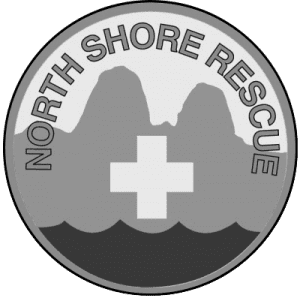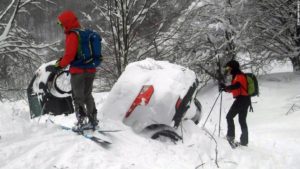We get this question on a fairly regular basis, and so we thought we would write a blog post in an attempt to answer it.
During the winter months, avalanche danger fluctuates from high to low, and outdoor recreationists wonder what is a safe day trip and what is not.
The 3 factors that contribute to avalanche danger are snowpack, terrain, and weather. If you have no snow or a solid snowpack, the danger is low. If the terrain is not avalanche terrain, meaning it is a low angled slope (below 25 degrees) and does not have avalanche terrain above it, then the danger is low. Weather also contributes to danger via wind, snow, and changing temperatures.
Many recreationists do not know if they are in avalanche terrain and many do not know how to evaluate the snowpack. As well, many people do not know how weather affects the avalanche risk. Avalanche Canada puts out danger bulletins but these are for a large general area and local conditions can vary widely.
A few select trails on the North Shore are generally ok to hike with elevated avalanche danger – obviously lower elevation hikes with no snow, and a few others. However, it is hard to say a particular trail is unconditionally SAFE. For example, a trail might head up beside a ski run. Most of the trail beside the ski run has low avalanche danger – it is travelled a lot and the ski runs are monitored by avalanche professionals. However, even a very small slide could carry you over a cliff or into a tree causing trauma. As well, if we go through a large storm cycle, and the trail becomes loaded with a large amount of fresh snow ready to slide, avalanche danger can go from low to high in a matter of hours. So is that trail really safe?
So when people ask, “Is it safe?” the answer is, well maybe, maybe not – what is your definition of “safe”? An avalanche professional may be totally comfortable operating in High avalanche danger in the backcountry as this person knows how to avoid avalanche terrain and considers this “safe.” Other people with lower levels of training would not be able to travel through the terrain safely.
If you are recreating in the backcountry in the snow then you should take an avalanche course.
Let me rephrase that – if you are recreating in the backcountry in the snow you definitely need to take an avalanche course.
There was a tragic rescue in 2017 of 5 snowshoers who died after a cornice collapse on Mt. Harvey. I don’t recall the avalanche danger rating that day – but the real danger was potential cornice collapses – which is something that is covered in avalanche courses.
So the question “Is it safe?” is something that is very challenging to answer for organizations like NSR. The other issue is if we say yes this trail is safe, but then someone trips on a slippery section and breaks their ankle, suddenly we could be liable and the trail was not actually “safe”. When someone emails us, we have no idea if someone has never walked on snow in their life – or if they have spent their entire life in the mountains.
Nature is dynamic and conditions change all the time. The best way to answer these questions is to take an Avalanche Canada course or courses, find some experienced people to go out with, hire an ACMG guide once or twice a year to lead a group and provide some instruction, and read some books, such as Mountaineering: The Freedom of the Hills. The Internet helps, and online groups help, but you also need to be careful with some of this advice, as you do not always know the experience level of the person providing it.
The AST 1 course is the recreational avalanche course where you should start. AST 2 is next, then you can start looking at CAA Level 1 and other related courses. They offer snowshoeing, skiing, and sledding related courses.
Go to: http://www.avalanche.ca/training/courses and sign up for a course today. It may save your life, or your friends life. Plus it’s a super fun weekend.

